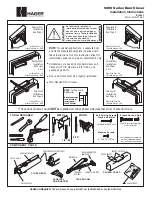
5. MAINTENANCE
6. CONTROL PANEL
5. MAINTENANCE
7. PROGRAMMING
Main Readout
indicates values according
to
which led above is operative.
Dual function button.
If pressed and released repeatedly, the display
will cycle through:
a) WeldING CURReNT
b) WIRe Feed RATe
c) SPOT Weld TIMe ( if selected )
If button is pressed for at least 3 seconds this
gives access to the WeldING PARAMeTeR
PROGRAMMING MOde. Press for at least 3
seconds again to exit from programming mode.
SELECT WELDING MATERIAL
. Select from:
Fe
(Ferrous metals),
Ss
(Stainless steel),
Al
(Aluminium),
CuSi
(copper silicon alloy ) or
CuAl
(copper aluminium alloy)
SELECT GAS
. Select from :
CO2
(Carbon dioxide),
ArCO2
(Argon / Carb.dioxide),
ArO2
(Argon / Oxygen),
Ar
(Argon)
OVERLOAD INDICATOR.
l.e.d lights up to indicate power has been cut off due to overheating. Readout
shows message
‘ALL thr’.
The system will reset automatically after the welder has cooled down.
SUPPLY VOLTAGE STATE.
l.e.ds indicate the state of power supply voltage.
Left hand LED on
indicates
low
mains supply voltage.
Middle LED on
shows mains supply voltage is
normal
.
Right hand LED on
shows mains voltage is too
high
.
LED ‘on’
means that the main readout is showing the WeldING CURReNT
.
LED ‘intermittent flashing’
means readout is showing
WIRe Feed RATe UP SlOPe in programming mode.
LED ‘on’
means main readout is showing the WIRe Feed RATe.
LED ‘intermittent flashing’
means main display is showing
WIRe BURN BACK TIMe in programming mode.
LED ‘on’
means readout is showing SPOT WeldING TIMe
LED ‘intermittent flashing’
means readout is showing
PRe-GAS TIMe in programming mode.
SELECT WIRE SIZE.
ROTARY KNOB :
Adjusts values
0.6mm, 0.8mm, 1.0mm
currently displayed in the readout above.
SELECT WELDING MODE
2/4touch or Spot welding.
DEFAULT LED.
Indicates that all programmed settings and
the wire feed rate have been returned to the default settings.
7.0
To enter programming mode hold down the dual function button below the display for at least 3 seconds. You now have access to 3 further parameters as
shown below. A single press of the button will change the display to the next parameter. Keep pressing the button until you reach the parameter you wish
to adjust.
7.1
WIRE FEED RATE UP SLOPE.
The wire feed motor start up can be adjusted from ‘slow’ to instantaneous. Adjust the values
‘r_1’
to
‘r_9’
using the
rotary knob. When the readout shows a value of
‘r_1’
this represents the slowest start up. When the readout shows
‘nor’
there is
no up slope applied
and the wire feed motor reaches its normal working speed immediately. To return to the factory default value press the WIRe and WeldING buttons
simultaneously for 3 seconds.
7.2
WIRE BURN BACK TIME.
Adjust the timing between 0.00 and 1.0 secs. using the rotary knob. To return to the factory default value press the WIRe and
WeldING buttons simultaneously for 3 seconds.
7.3
PRE-GAS TIME.
Adjust the timing between 0.00 and 3.0 secs. using the rotary knob. To return to the factory default value press the WIRe and
WeldING buttons simultaneously for 3 seconds.
7.4
To exit the programming mode at any time press the dual function button below the readout for at least 3 seconds.
7.5
ReSeTTING All PARAMeTeRS TO The deFAUlT VAlUeS. If the WeldING and WIRe buttons are pressed simultaneously, all programming
parameters and the wire feed rate are returned to the factory settings.
5. MAINTENANCE
8. WELDING PRINCIPLES
8.1
Mig/Mag welding. (See fig 8 ).
A spool of welding wire is placed on spool holder and automatically fed through an
insulated liner in the torch to its tip. The torch consist of a switch, liner, gas hose, and control cable. The switch
activates the wire feed roller and the gas flow. Releasing the switch stops wire feed and gas flow. The weld current is
transferred to the electrode (the wire) from the contact tip at the torch end. The wire speed will be automatically
adjusted according to power output. ( The wire speed can also be manually adjusted. ) The higher the current the faster
the wire speed. A gas cup fits over the contact tip to direct gas flow towards the weld ensuring the arc welding process
is shielded from oxidising air contamination (fig 8). The shielding gas also assists heating of the weld. The torch is
connected to the positive side of a dC rectifier, and negative clamp is attached to the workpiece.
8.2
Gas types and their use.
Welding mild steel with CO
2
gas is appropriate for most welding tasks where spatter and high build up of weld do not
pose a problem. To achieve a spatter free and flat weld however, you must use an Argon/CO
2
mixture.
To weld aluminium use:
Argon gas or Argon-helium mixture,
0.8mm Contact Tip,
0.8mm Aluminium Wire
8.3
Aluminium Welding.
Argon or an Argon-helium mixture should be used for shielding. The wire used must have the
same characteristics as the material to be welded. Always use an alloy wire (i.e. aluminium/silicon); dO NOT use pure
aluminium wire. A problem you may experience when aluminium MIG welding is in pulling the wire for the whole length of the torch, as aluminium has poor
mechanical characteristics. The smaller the diameter of wire the more difficult the wire feed may be. To overcome this problem, replace the torch guide
hose with a Teflon guide hose. To withdraw the hose loosen screws at the end of the torch. Use a contact tip suitable for aluminium. Replace the wire puller
rollers with aluminium compatible rollers. Replace the steel guide hose for wire feed with a Teflon guide hose. Alternatively a spool gun for welding
aluminium is available as an optional extra. A small reel of aluminium wire is directly mounted onto the torch itself which eliminates the need for a long liner.
Contact your local Sealey dealer for information.
fig 8
Original Language Version
eleCTROMIG195.V3 Issue: 3 - 08/03/10

























